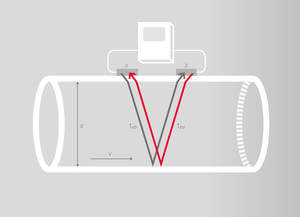How does liquid flow measurement work?
We develop and manufacture portable and fixed installation clamp-on flowmeters for liquids, which maintain high quality production standards and performance characteristics. We believe that the measurement of flow should be quick, easy and straightforward. We have therefore equipped every KATflow clamp-on flowmeter with an intuitive menu, instrument Setup Wizard and the unique Audible Sensor Positioning Assistant to make our flowmeters the easiest to operate and install available.
Katronic ultrasonic flowmeters can measure on pipes of all standard materials over a large diameter range and are suitable for process liquids from pure water to chemicals and effluents. The instruments measure over a range of 0.01… 25 m/s and a repeatability of 0.15 %.
To ensure the long term performance and reliability of our products, KATflow instruments are supplied with stainless steel transducers as standard on all models and housings designed to withstand even the most harsh environmental conditions.

 Overview
Overview Oil and Gas
Oil and Gas Manufacturing and Process
Manufacturing and Process Food and Drink
Food and Drink Building Services
Building Services Aircraft and Aerospace
Aircraft and Aerospace Chemical and Petrochemical
Chemical and Petrochemical Power Generation
Power Generation Marine and Shipbuilding
Marine and Shipbuilding Water and Wastewater
Water and Wastewater Pharmaceutical
Pharmaceutical Flowmeter Hire and Rental
Flowmeter Hire and Rental Measurement Service
Measurement Service Training
Training Commissioning
Commissioning Special Solutions
Special Solutions


